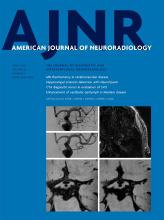Index by author
Hahn, S.Y.
- Head and Neck ImagingOpen AccessRadiomics Study of Thyroid Ultrasound for Predicting BRAF Mutation in Papillary Thyroid Carcinoma: Preliminary ResultsM.-r. Kwon, J.H. Shin, H. Park, H. Cho, S.Y. Hahn and K.W. ParkAmerican Journal of Neuroradiology April 2020, 41 (4) 700-705; DOI: https://doi.org/10.3174/ajnr.A6505
Han, M.H.
- Adult BrainYou have accessSuspected Metallic Embolization Distal to Coiled Intracranial Aneurysms Detectable by Susceptibility-Weighted MR ImagingD.H. Yoo, Y.D. Cho, H.S. Lee, S.H. Kim, D. Jang, S.H. Lee, W.-S. Cho, H.-S. Kang, J.E. Kim and M.H. HanAmerican Journal of Neuroradiology April 2020, 41 (4) 619-623; DOI: https://doi.org/10.3174/ajnr.A6506
Harteveld, A.A.
- EDITOR'S CHOICEAdult BrainOpen AccessMRI Vessel Wall Imaging after Intra-Arterial Treatment for Acute Ischemic StrokeA. Lindenholz, I.C. van der Schaaf, A.G. van der Kolk, H.B. van der Worp, A.A. Harteveld, L.J. Kappelle and J. HendrikseAmerican Journal of Neuroradiology April 2020, 41 (4) 624-631; DOI: https://doi.org/10.3174/ajnr.A6460
The authors compared vessel wall enhancement after intra-arterial thrombosuction with that in patients not treated by thrombosuction in a group of 49subjects with ischemic stroke with 7T MR imaging within 3 months after symptom onset. In the intra-arterial treatment group, 11 of 14 patients (79%) showed vessel wall enhancement compared with 17 of 35 patients without intra-arterial treatment (49%). In the intra-arterial treatment group, more enhancing foci were detected on the ipsilateral side compared with the contralateral side. They conclude that patients with intra-arterial treatment by means of thrombosuction showed more (concentric) enhancing foci of the vessel wall ipsilateral compared with contralateral to the treated artery than the patients without intra-arterial treatment, suggesting reactive changes of the vessel wall.
Hautefort, C.
- EDITOR'S CHOICEHead and Neck ImagingYou have accessComparison of Enhancement of the Vestibular Perilymph between Variable and Constant Flip Angle–Delayed 3D-FLAIR Sequences in Menière DiseaseS. Nahmani, A. Vaussy, C. Hautefort, J.-P. Guichard, A. Guillonet, E. Houdart, A. Attyé and M. EliezerAmerican Journal of Neuroradiology April 2020, 41 (4) 706-711; DOI: https://doi.org/10.3174/ajnr.A6483
The authors compared the degree of perilymphatic enhancement and the detection rate of endolymphatic hydrops using constant and variable flip angle sequences in 16 patients with 3T MR imaging. Both for symptomatic and asymptomatic ears, the median signal intensity ratio was significantly higher with the constant flip angle than with the heavily-T2 variable flip angle. Cochlear blood-labyrinth barrier impairment was observed in 4/18 symptomatic ears with the heavily-T2 variable flip angle versus 8/19 with constant flip angle sequences. They conclude that 3D-FLAIR constant flip angle sequences provide a higher signal intensity ratio and are superior to heavily-T2 variable flip angle sequences in reliably evaluating the cochlear blood-labyrinth barrier impairment.
Heijboer, R.J.J.
- FELLOWS' JOURNAL CLUBAdult BrainYou have accessCT Angiography in Evaluating Large-Vessel Occlusion in Acute Anterior Circulation Ischemic Stroke: Factors Associated with Diagnostic Error in Clinical PracticeB.A.C.M. Fasen, R.J.J. Heijboer, F.-J.H. Hulsmans and R.M. KweeAmerican Journal of Neuroradiology April 2020, 41 (4) 607-611; DOI: https://doi.org/10.3174/ajnr.A6469
This study included 520 consecutive patients with a clinical diagnosis of acute ischemic stroke (49.4% men; mean age, 72 years) who underwent CTA to evaluate large-vessel occlusion of the proximal anterior circulation. CTA scans were retrospectively reviewed by a consensus panel of 2 neuroradiologists. The prevalence of large-vessel occlusion was 16% (84/520 patients); 20% (17/84) of large-vessel occlusions were missed atthe initial CTA evaluation. In multivariate analysis, non-neuroradiologists were more likely to miss large-vessel occlusion compared with neuroradiologists, and occlusions of the M2 segment were more likely to be missed compared with occlusions of the distal internal carotid artery and/or M1 segment. Calcified emboli were present in 4 of 17 (24%) initially missed or misinterpreted large-vessel occlusions.
Hendrikse, J.
- EDITOR'S CHOICEAdult BrainOpen AccessMRI Vessel Wall Imaging after Intra-Arterial Treatment for Acute Ischemic StrokeA. Lindenholz, I.C. van der Schaaf, A.G. van der Kolk, H.B. van der Worp, A.A. Harteveld, L.J. Kappelle and J. HendrikseAmerican Journal of Neuroradiology April 2020, 41 (4) 624-631; DOI: https://doi.org/10.3174/ajnr.A6460
The authors compared vessel wall enhancement after intra-arterial thrombosuction with that in patients not treated by thrombosuction in a group of 49subjects with ischemic stroke with 7T MR imaging within 3 months after symptom onset. In the intra-arterial treatment group, 11 of 14 patients (79%) showed vessel wall enhancement compared with 17 of 35 patients without intra-arterial treatment (49%). In the intra-arterial treatment group, more enhancing foci were detected on the ipsilateral side compared with the contralateral side. They conclude that patients with intra-arterial treatment by means of thrombosuction showed more (concentric) enhancing foci of the vessel wall ipsilateral compared with contralateral to the treated artery than the patients without intra-arterial treatment, suggesting reactive changes of the vessel wall.
Hendrix, P.
- NeurointerventionYou have accessThe FRED for Cerebral Aneurysms of the Posterior Circulation: A Subgroup Analysis of the EuFRED RegistryC.J. Griessenauer, M.A. Möhlenbruch, P. Hendrix, C. Ulfert, C. Islak, M. Sonnberger, T. Engelhorn, E. Müller-Thies-Broussalis, T. Finkenzeller, M. Holtmannspötter, J.-H. Buhk, W. Reith, A. Simgen, H. Janssen, N. Kocer and M. Killer-OberpfalzerAmerican Journal of Neuroradiology April 2020, 41 (4) 658-662; DOI: https://doi.org/10.3174/ajnr.A6447
Hince, D.A.
- NeurointerventionYou have accessGlasgow Coma Scale on Presentation Predicts Outcome in Endovascular Treatment for Acute Posterior Large-Vessel OcclusionA.H. Chiu, D.A. Hince and W. McAuliffeAmerican Journal of Neuroradiology April 2020, 41 (4) 645-649; DOI: https://doi.org/10.3174/ajnr.A6497
Hirsch, J.A.
- EditorialOpen AccessNovel Coronavirus: What Neuroradiologists as Citizens of the World Need to KnowA. Mahajan and J.A. HirschAmerican Journal of Neuroradiology April 2020, 41 (4) 552-554; DOI: https://doi.org/10.3174/ajnr.A6526
Holtmannspotter, M.
- NeurointerventionYou have accessThe FRED for Cerebral Aneurysms of the Posterior Circulation: A Subgroup Analysis of the EuFRED RegistryC.J. Griessenauer, M.A. Möhlenbruch, P. Hendrix, C. Ulfert, C. Islak, M. Sonnberger, T. Engelhorn, E. Müller-Thies-Broussalis, T. Finkenzeller, M. Holtmannspötter, J.-H. Buhk, W. Reith, A. Simgen, H. Janssen, N. Kocer and M. Killer-OberpfalzerAmerican Journal of Neuroradiology April 2020, 41 (4) 658-662; DOI: https://doi.org/10.3174/ajnr.A6447








